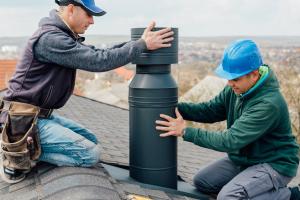Mastering Your Home: The Ultimate Guide to Cleaning Chimneys for Safety and Efficiency

-
Quick Links:
- Introduction
- Importance of Cleaning Chimneys
- When to Clean Your Chimney
- Tools and Materials Needed
- Step-by-Step Guide to Cleaning Your Chimney
- Safety Tips and Precautions
- Hiring a Professional Chimney Sweep
- Case Studies
- Expert Insights
- FAQs
Introduction
Chimneys play a crucial role in maintaining the safety and efficiency of your home heating system. However, many homeowners overlook the importance of regular chimney cleaning. This comprehensive guide is designed to equip you with all the knowledge you need to effectively clean your chimney, ensuring your home remains safe and warm.
Importance of Cleaning Chimneys
Cleaning your chimney is essential for several reasons:
- Fire Safety: A buildup of creosote, a flammable substance, can lead to chimney fires.
- Efficient Heating: A clean chimney allows for better airflow, enhancing the efficiency of your fireplace or stove.
- Preventing Carbon Monoxide Poisoning: Blocked chimneys can lead to dangerous gases entering your home.
When to Clean Your Chimney
Knowing when to clean your chimney is critical. Here are some indicators:
- After burning 1 cord of wood in a season.
- If you notice a strong odor from the chimney.
- When you see soot or creosote buildup on the chimney walls.
Tools and Materials Needed
Before starting your chimney cleaning project, gather the following tools and materials:
- Chimney brush
- Extension rods
- Drop cloth
- Safety goggles and gloves
- Flashlight
- Vacuum cleaner
Step-by-Step Guide to Cleaning Your Chimney
To clean your chimney effectively, follow these detailed steps:
Step 1: Prepare the Area
Lay down a drop cloth around your fireplace to catch any debris. Ensure the room is well-ventilated.
Step 2: Inspect Your Chimney
Use a flashlight to inspect the interior of your chimney for blockages, cracks, or soot buildup. This will help you identify the extent of the cleaning required.
Step 3: Attach the Chimney Brush
Attach your chimney brush to the extension rods. Ensure it is secure to prevent detachment during cleaning.
Step 4: Start Cleaning from the Top
If possible, clean the chimney from the top down. This method allows debris to fall into the fireplace, making cleanup easier.
Step 5: Work the Brush Up and Down
Using a firm grip, scrub the walls of the chimney with the brush, working it up and down to dislodge soot and creosote.
Step 6: Remove the Debris
Once you've cleaned the chimney, remove the brush and vacuum any soot or debris from the fireplace.
Step 7: Final Inspection
Conduct a final inspection of the chimney to ensure it's clean and free from any obstructions.
Safety Tips and Precautions
Before you start cleaning your chimney, keep these safety tips in mind:
- Always wear safety goggles and a mask to protect against soot and dust.
- Ensure the fireplace is cold and free from embers before starting.
- Use a sturdy ladder if accessing the chimney from the roof.
Hiring a Professional Chimney Sweep
If you're uncomfortable cleaning your chimney yourself, hiring a professional is a wise choice. Here are some tips for selecting a reputable chimney sweep:
- Look for certified professionals through organizations like the Chimney Safety Institute of America (CSIA).
- Check online reviews and ask for references.
- Ensure they provide a detailed estimate before starting the work.
Case Studies
Consider the case of a family in Illinois who neglected their chimney maintenance. After a particularly cold winter, they experienced a chimney fire due to excessive creosote buildup. Fortunately, no one was injured, but they incurred significant costs for repairs and cleanup. Regular maintenance could have prevented this incident.
Expert Insights
According to chimney sweep expert John Smith, “Regular chimney cleaning not only prevents fires but also improves the efficiency of your heating system. Homeowners should prioritize this maintenance to protect their families.”
FAQs
1. How often should I clean my chimney?
It is recommended to clean your chimney at least once a year, especially if you use it frequently.
2. Can I clean my chimney myself?
Yes, you can clean your chimney yourself if you have the right tools and follow safety precautions.
3. What are the signs of a dirty chimney?
Signs include a strong odor, visible soot, or difficulty starting a fire.
4. How much does it cost to hire a professional chimney sweep?
Costs can vary, but expect to pay between $100 and $300 depending on your location and the extent of the cleaning.
5. What is creosote?
Creosote is a byproduct of burning wood that can accumulate in your chimney and is highly flammable.
6. Is it safe to use my fireplace if my chimney is dirty?
No, using a fireplace with a dirty chimney can increase the risk of chimney fires and carbon monoxide buildup in your home.
7. Can I use a store-bought chimney cleaning product?
Yes, these products can help reduce creosote buildup but should not replace regular cleaning.
8. What is the best time of year to clean my chimney?
Late summer or early fall is ideal before the heating season begins.
9. Do I need to clean my chimney if I only use it occasionally?
Yes, even occasional use can lead to buildup, so annual cleaning is still recommended.
10. What should I do if I find a blockage in my chimney?
If you find a blockage, it’s best to contact a professional to safely remove it.
For further reading on chimney safety, visit:
Random Reads
- Mastering horse riding in minecraft
- Mastering hexadecimal
- Find your stolen phone lock or erase a lost device
- Mastering fishing stardew valley switch
- How to make a help file
- How to make a graph in microsoft word
- How to beat bowser in super mario world
- How to beat 2048
- How to remove ice from driveway
- How to remove item from image in photoshop